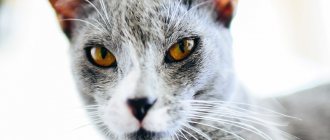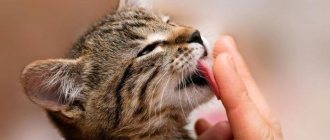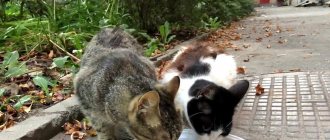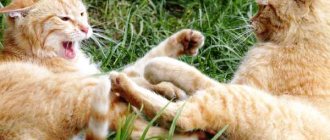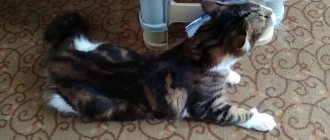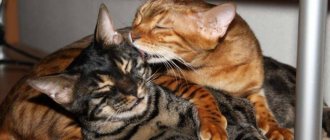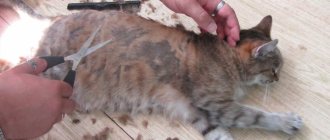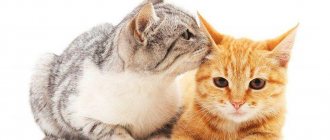11/13/2021 7,973 Interesting things about cats
Author: Olga
Often, many cat owners have absolutely no idea what their cute furry treasure is trying to say. Not understanding cat language, a person misses the pet’s request to be petted, fed, or simply allowed to lie quietly. Many people have at least once dreamed of learning to understand or read the sign language of cat communication. But, despite the fact that everything seems complicated, in fact you just need to be extremely attentive to the animal’s behavior and the sounds it makes. After all, cats are more open interlocutors than people. And you can verify this right now.
[Hide]
Do cats understand human speech?
Cats have lived next to humans for several thousand years, but we still have not fully learned to understand them.
- Most cat owners are interested in the question of whether cats understand human speech.
- Numerous studies show that pets can understand human speech (up to approximately 100 words), but we are not talking about complete understanding.
- Cats only remember individual words, but what they perceive best is the intonation with which these words were spoken. Cats are also good at remembering their name.
Animals clearly sense by their voice when the owner is angry or joyful, sad or angry. Cats behave in accordance with the intonations they hear.
If the owner is angry with the cat, then he stops the unwanted act, and if he affectionately calls him to him, then he goes into his arms.
The relationship between color and character
Professor Helmut Hemmer claims that a cat's character often coincides with its color. In his opinion:
- black cats are affectionate, curious, but a little nervous;
- black and white - sociable, excellent friends for children, very attached to their owners;
- striped - closed, sometimes avoid communication, very freedom-loving, independent;
- red, white and red are real homebodies, they need peace;
- Whites are capricious and touchy creatures, but wonderful by nature.
How does a cat communicate with its owner?
Many cat owners are interested in the question of how to understand a cat. To do this, tailed pets have all sorts of body movements, as well as many sounds. They may use purrs, hisses, soft or loud meows, and other sounds.
In addition, cats communicate with people by extending their claws, turning their ears or head, scratching, biting or rolling on their back. Purring is a sign of pleasure, happiness and calmness. It is possible that your kitty needs food, attention or affection.
Living with a cat, the owner will easily begin to notice the difference between the cat's purring. This often depends on the time of day or where the cat is when she purrs.
A growl or hiss indicates that the cat is determined to protect its interests and desires to the last.
How to understand the behavior of cats if your pets want to tell you something using gestures or behavioral patterns? Cat owners know very well that tails are the most expressive and emotional organs of their pets.
- Thanks to the movements of the tail, animals clearly demonstrate their desires or mood.
- Waving the tip of its tail - a cat shows everyone around that it is very interested in something.
- Waving its tail indicates that the pet is very worried.
- If a cat holds its tail up, it means that the pet is very surprised or in a fighting mood.
- But a drooping tail is a symptom of depression or a sign of fatigue.
In the case when a cat clamps its tail between its hind legs, this is a manifestation of fear or fright. A relaxed and motionless cat's tail expresses that the pet is in a great mood.
The arched back and the fur standing on end demonstrates a threat. This is how the cat wants to appear larger than he really is. Most often, a cat scares a dog with this look. If she keeps her head straight, then she is not afraid of her opponent.
Communication using limbs
If a pet gently moves its furry paws and at the same time releases its claws, then the animal is content and in a state of complete peace. Being in a good mood and feeling bliss, cats begin to mentally return to their early years. As a small kitten, the animal sucked its mother's milk and kneaded her belly with its paws. In addition to moving its paws, the cat begins to purr gently and soothingly.
Note! In such moments of bliss, the cat can forget itself and begin to release its claws, digging into the owner’s body. It is not recommended to scold or sharply pull your pet, as this can greatly offend an impressionable animal. It is best to carefully move the cat and pet it.
Very often, cats show their love for their owner by gently hugging them with their paws. But if the paw is raised sharply upward, with its claws extended, it means that the cat is preparing to defend itself and is determined.
Signs of cat love
How to understand that a cat loves you? Feline behavior experts believe that pets truly love their owners and enjoy being with them.
Below are signs that indicate your indoor cat has a strong attachment to you:
- The pet rubs against your legs or arms. This is the main sign that he has accepted you into his inner circle;
- The cat simply follows the owner's heels;
- Your pet kneads its front paws on your stomach or shoulder;
- He shows his belly to the owner, and this is the main sign of pleasure and complete trust.
Licking the owner’s ears or hair also speaks of a cat’s love. This type of “care” is an undeniable manifestation of warm feelings for the owner.
Other signs of cat favor
Cats often hide from strangers or even hiss at them, but they treat their own people more kindly. The cat's slowly closing eyes, the desire to play with the owner, and the location next to him on the sofa speak about a cat's trust and love. They understand very well who is their friend.
How to determine if a cat is sick
It is necessary to learn to distinguish a sick cat from a healthy one. This will help to provide her with feasible and timely assistance, and, if necessary, tell the veterinarian about the symptoms of the disease and the pet’s behavior. How can you tell if your cat is sick?
- When communicating with a pet, you should regularly check its teeth and gums, ears, and the condition of its eyes and skin.
- A serious sign of ill health is a cat losing weight.
- Another important symptom of visiting a veterinarian is a change in your pet’s behavior.
If the cat has become lethargic and apathetic, gets tired quickly, and also has an impaired appetite, then these are sure signs to visit a veterinary clinic with your pet.
In principle, any disturbance in the pet’s diet should alert the owner. The cat may start eating more or less - most likely she has health problems. She may also not eat at all for several days - then you need to urgently take her for a consultation with a veterinarian.
- You also need to pay attention to whether the cat takes care of itself.
- After all, they are very clean animals and love to lick their fur.
- Therefore, if your pet does not pay attention to grooming, then he probably does not feel completely healthy.
Research on cats' moods, feelings and emotions is much inferior to that of dogs, but their quantity and quality has been steadily increasing over the last decade. And although these observations are only at the beginning of their journey, they already demonstrate that the ability of cats to communicate with humans is a very complex and multifaceted thing.
To figure out whether cats understand people, you need to learn to master their language. This will allow you to establish the most trusting emotions with your pet. Respectful and close relationships in return for respect and love.
Expressing emotions using ears and eyes
Cats' ears are excellent radars, designed to detect various sound waves. It is noteworthy that a cat in a state of wakefulness can detect the sound made by rodents at a distance of more than 20 meters. In search of a sound source, a cat can rotate its ear 180 degrees. More than 30 different muscles are involved in the ear's unique ability to bend, press, and rotate.
There are a number of emotions expressed through the position of the ears:
- A cat can express a good mood and positive attitude using its ears. In this case, they will be strictly in front at the top of the head.
- The placement of the ears in different directions or flat means that the cat is at a loss, not understanding what is happening.
- Dropped or pinned ears are a signal to attack; the pet is ready to defend itself and it is better to leave it alone.
- Ears turned and pressed back are a sign of rage and anger.
- Twitching ears means that the cat is nervous and irritated. This movement is often observed when the pet is watching a potential victim.
It’s not just a cat’s ears that can indicate the animal’s mood. The visual organ – the eyes, like people’s – can express a whole range of emotions. When a pet looks with an open, calm gaze, it means that she is happy with everything or is interested in the action taking place. There is an opinion among breeders and cat lovers that with the help of a look a cat can express its love for its owner. In this case, the animal looks straight into the eyes of its owner for a long time and devotedly, and then slowly closes its eyes.
